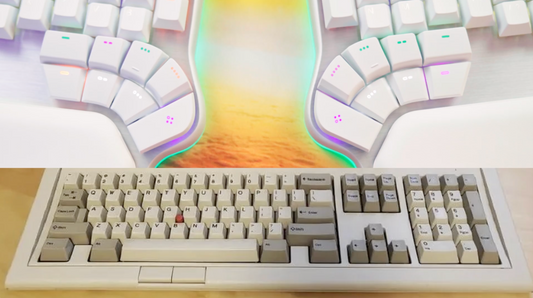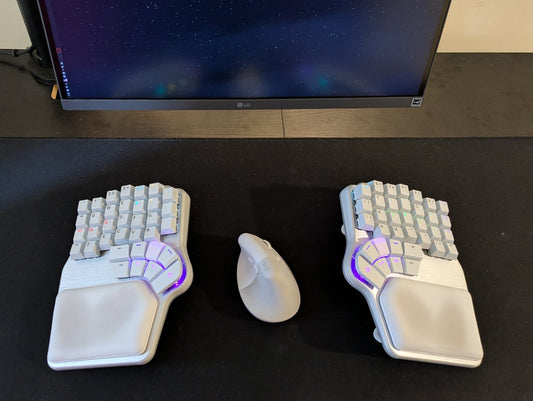When we sent the wireless Dygma Defy to the lab for the certification tests a month ago, we knew we were in for a ride: it's always fun to work with other engineers overseas, with time zones and different languages getting in the way. But what has happened over the last few weeks is worth making a soap opera out of it 😅
The good news is we know that we’re not in the worst-case scenario: after all the ups and downs and a couple of heart scares, the Dygma Defy has passed the Bluetooth certification 🎉

This means that the body of the keyboard doesn’t interfere with the wireless connectivity, and we don’t have to make changes to the mechanical design.
The not-so-good news is that we haven’t been able to do the RF certification yet. Why? Because, wait for it, the keyboard was damaged while it was being prepared for testing 😱
How in the name of Alan Turing did that ever happen, and how did we solve it? Well, buckle up and enjoy the ride!
Two keyboards are (not) too many

To be ready for testing, we prepared two keyboards —one to test Bluetooth and another to test 2.4 GHz RF. Well, technically, it was one and a half keyboards because the Bluetooth version only needed the left side and a Neuron to be tested (and the other half was being used to take some measurements of the antenna in another lab).
We did this to speed up the process. With two keyboards, they could test them simultaneously, and we’d also avoid unnecessary firmware flashing.

Right now, Bluetooth and RF are two different firmware that we still have to merge into one. If we only gave them one keyboard, they’d need to change the firmware between tests.
Replacing the firmware in these manufacturing prototypes is not an easy process – we have various step-by-step guides that are 10+ pages long– so having two pre-flashed keyboards would save time and headaches.

However, the lab soon crushed our hopes of a fast certification: they wanted to test Bluetooth and RF on the same keyboard. And they wanted to start with Bluetooth 🥺
The problem was that their only complete keyboard already had the RF firmware. Fortunately, we planned for this: we included a bootloader mode to flash new firmware with a smartphone app. Isn’t that cool? Well, not if you’re a Chinese lab without access to Google Play 🤦♀️
We didn’t foresee this issue because our electronics manufacturer had downloaded the app without problems. After different failed attempts, the lab got hold of an iPhone with access to the App Store and installed the app –If you’re interested in which app we’re talking about, it’s nRF Device Firmware Update by Nordic Semiconductor ASA.

But that was not the end of it. Even with our detailed documentation explaining the firmware update process in detail, the lab had trouble flashing it.
Judging by the questions and problems they were facing, it seemed like they didn’t even read the manual, but after several calls and messages, we got it sorted out. Sadly, we lost almost a whole week in the process 😭
With the correct firmware in place, the lab went on to do the BLE testing, and after a couple of weeks of nervous wait and constant communication with the lab, we got the good news: the Dygma Defy had passed the Bluetooth certification 🍾
That was literally Friday last week, and we were full of joy. The RF certification was next; if that was good too, we were in the green to manufacture. But that joy lasted just for the weekend. On Monday, we woke up with terrible news: the right side of the Defy wouldn’t turn on 🙃
Manuals? Where we are going, we DO need manuals!
To prepare for the tests, our electronics engineer created a website-like manual full of explanations, pictures, diagrams, schematics, 3Ds of the PCBs, step-by-step instructions, videos, documentation, links, etc.

Of course, that Dygma Defy Encyclopedia included instructions on what to do if the keyboard didn’t turn on and a step-by-step disassembly guide that would make iFixit blush.
Well, they most certainly didn’t read any of that either because, while opening the keyboard to see what was wrong with it, they snapped a cable that damaged the PCBs 💔

So now what?
If you recall from a few paragraphs ago, the lab only had one right side of the keyboard; that means we couldn’t make one keyboard out of two 😔
However, we did have another set of Keyscanner and RF PCBs nearby: the ones we sent to measure the antenna parameters.

Right now, those PCBs and the broken keyboard are on their way to our electronics manufacturer to be fixed. Once it’s up and running again, they’ll send the Defy to the lab to undergo the RF and wired testing.
The lab should receive it by Monday at the latest, and the test should be finished by the end of next week, so we’d only be a couple of weeks late in our planning for the certification 🙏
Suppose the rest of the testing goes well, and we don’t have to change the electronics. In that case, we could start manufacturing right afterward, and the Defy would be ready to be shipped to our warehouse in Spain before the Chinese New Year (which begins on January 22nd).
Once it arrived at our facilities, we’d do the final assembly, quality control, and fulfillment, which would occur during February.
Bonus track: the Antennagate

About two months ago, we sent the RF and Neuron PCBs to another lab to get some measurements out of the antennas –to be precise, the antenna gain and pattern, which are needed for the certification tests.
With our luck, the package containing the PCBs got quarantined for two weeks because of COVID, but we got the results in time to not block the certification tests 🙌
The data obtained was overall quite good; we have a pretty evenly distributed radiation pattern, meaning there are no significant blind spots in our antennas.

However, one thing popped out: the antenna matching was off.
To ensure maximum range, minimum power consumption, reduced heating, and reliable data throughput, you must match the antenna’s input impedance to the RF circuity’s output impedance (50 Ω in most cases).
If you want to know more about antenna matching, read this document.
We’re taking new measurements in another lab here in Spain to double-check before making any changes, but we’ll probably need to make some changes to the PCBs’ design 😔
Fortunately, those changes won’t be significant enough to re-do the certification tests, but redesigning the electronics could imply delays in manufacturing.
What’s next
To sum it up: the certification has been bumpy but with good results so far, and the new ETA for the Defy is February.
We know delays suck, but getting the certification and the electronics right is critical. That’s why we’ve hired a new electronics engineer. He’s started working this week, and he’s already helping with the antennagate 😊
And to make everything move forward faster and avoid further delays, our lead product designer, Manel, is traveling to China next week, and he’ll stay there for a month to ensure manufacturing is on track.
We really appreciate your support throughout this whole process 🥰
Paalam 🇵🇭









